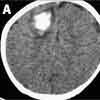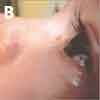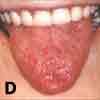Photoclinic: Hereditary Hemorrhagic Telangiectasia
A 3-month-old infant was brought for evaluation after the sudden development of a tonic-clonic seizure that involved the left upper extremity. He had no history of fever, trauma, rash, refusal to suck, vomiting, diarrhea, upper respiratory tract infection symptoms, or bleeding. He was not taking any medications.


A 3-month-old infant was brought for evaluation after the sudden development of a tonic-clonic seizure that involved the left upper extremity. He had no history of fever, trauma, rash, refusal to suck, vomiting, diarrhea, upper respiratory tract infection symptoms, or bleeding. He was not taking any medications.
The infant was born via uncomplicated vaginal delivery. His antenatal and neonatal history was unremarkable. He had one healthy male sibling. The mother and grandmother had histories of epistaxis.
Growth parameters, vital signs, and physical examination findings --including cranial fontanelles and fundi--were normal. No scalp bruise was noted.
Results of a complete blood cell count with differential and a chest radiograph were normal. Results of the following tests were also normal: urinalysis, prothrombin time, activated partial thromboplastin time, factor VIII, Vw antigen, ristocetin cofactor activity, protein C, protein S, antithrombin 3 level and activity, serum homocysteine level, anti-DNA antibodies, anticardiolipin antibodies, and rheumatoid factor.


A CT scan revealed a hemorrhage in the right frontal lobe; the scalp was intact (A). On close examination, a telangiectasia was observed on the infant's nose (B); similar lesions were present on the grandmother's lips and tongue (C and D). The patient's intracranial bleeding, family history of epistaxis with normal hemostasis, and telangiectasia that was also present in a close relative suggested hereditary hemorrhagic telangiectasia (HHT).
HHT--also known as Rendu-Osler-Weber syndrome--is characterized by multiple arteriovenous malformations, or telangiectasias, of the skin and mucous membranes that often rupture and bleed after slight trauma. The most common clinical manifestation is spontaneous and recurrent epistaxis (nighttime epistaxis, in particular). Mucocutaneous telangiectasias characteristically present as small red spots or delicate, lacy red vessels on the lips, oral cavity, fingers, or nose. Large arteriovenous malformations in the brain, lungs, or GI tract can cause bleeding or shunting that may result in sudden and catastrophic complications (eg, anemia and heart failure).
The diagnosis of HHT is based on a family history of the condition, epistaxis, cutaneous or mucocutaneous telangiectasia, and visceral organ manifestations. The presence of 3 of 4 of these criteria is sufficient for diagnosis. HHT rarely presents as intracranial bleeding. Bhagwan Das Bang, MD, of Opp, Ala, notes that this case was unusual because the severe bleeding occurred very early in life. The thorough history taking and close examination of this patient were most important in the clinical assessment.
The incidence of HHT is estimated to be 1 in 5000 worldwide, which is much more common than previously thought.1 HHT is caused by a mutation in either the endoglin gene or the activin receptor gene (ALK-1). It is believed to be inherited in an autosomal dominant manner. Most persons with HHT have an affected parent. Molecular genetic testing is recommended, but it may not be an option for some families because of cost. This patient was referred to the University of Alabama Hospital in Birmingham. A neurologist, neurosurgeon, pulmonologist, and occupational and physical therapist are following up with the patient.
References:
REFERENCE:
1.
Giordano P, Nigro A, Lenato GM, et al. Screening for children from families with Rendu-Osler-Weber disease: from geneticist to clinician.
J Thromb Haemost.
2006;4:1237-1245.
Recognize & Refer: Hemangiomas in pediatrics
July 17th 2019Contemporary Pediatrics sits down exclusively with Sheila Fallon Friedlander, MD, a professor dermatology and pediatrics, to discuss the one key condition for which she believes community pediatricians should be especially aware-hemangiomas.